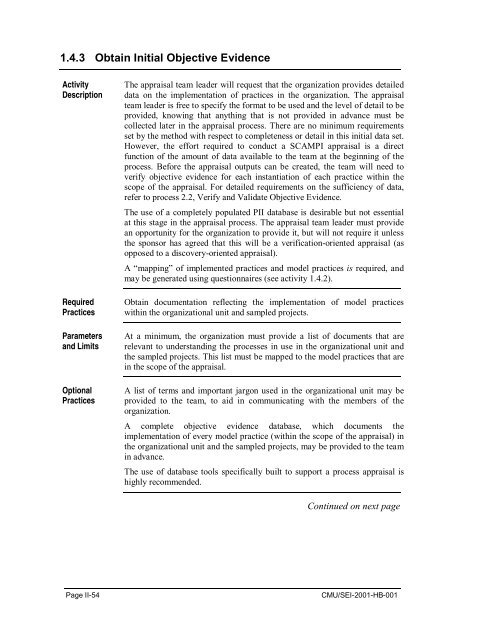Standard CMMI Appraisal Method for Process Improvement (SCAMPI)
Standard CMMI Appraisal Method for Process Improvement (SCAMPI)
Standard CMMI Appraisal Method for Process Improvement (SCAMPI)
Create successful ePaper yourself
Turn your PDF publications into a flip-book with our unique Google optimized e-Paper software.
1.4.3 Obtain Initial Objective Evidence<br />
Activity<br />
Description<br />
Required<br />
Practices<br />
Parameters<br />
and Limits<br />
Optional<br />
Practices<br />
The appraisal team leader will request that the organization provides detailed<br />
data on the implementation of practices in the organization. The appraisal<br />
team leader is free to specify the <strong>for</strong>mat to be used and the level of detail to be<br />
provided, knowing that anything that is not provided in advance must be<br />
collected later in the appraisal process. There are no minimum requirements<br />
set by the method with respect to completeness or detail in this initial data set.<br />
However, the ef<strong>for</strong>t required to conduct a <strong>SCAMPI</strong> appraisal is a direct<br />
function of the amount of data available to the team at the beginning of the<br />
process. Be<strong>for</strong>e the appraisal outputs can be created, the team will need to<br />
verify objective evidence <strong>for</strong> each instantiation of each practice within the<br />
scope of the appraisal. For detailed requirements on the sufficiency of data,<br />
refer to process 2.2, Verify and Validate Objective Evidence.<br />
The use of a completely populated PII database is desirable but not essential<br />
at this stage in the appraisal process. The appraisal team leader must provide<br />
an opportunity <strong>for</strong> the organization to provide it, but will not require it unless<br />
the sponsor has agreed that this will be a verification-oriented appraisal (as<br />
opposed to a discovery-oriented appraisal).<br />
A “mapping” of implemented practices and model practices is required, and<br />
may be generated using questionnaires (see activity 1.4.2).<br />
Obtain documentation reflecting the implementation of model practices<br />
within the organizational unit and sampled projects.<br />
At a minimum, the organization must provide a list of documents that are<br />
relevant to understanding the processes in use in the organizational unit and<br />
the sampled projects. This list must be mapped to the model practices that are<br />
in the scope of the appraisal.<br />
A list of terms and important jargon used in the organizational unit may be<br />
provided to the team, to aid in communicating with the members of the<br />
organization.<br />
A complete objective evidence database, which documents the<br />
implementation of every model practice (within the scope of the appraisal) in<br />
the organizational unit and the sampled projects, may be provided to the team<br />
in advance.<br />
The use of database tools specifically built to support a process appraisal is<br />
highly recommended.<br />
Continued on next page<br />
Page II-54<br />
CMU/SEI-2001-HB-001
















